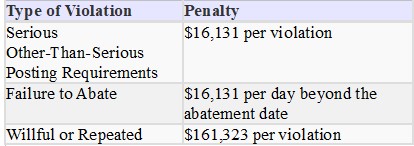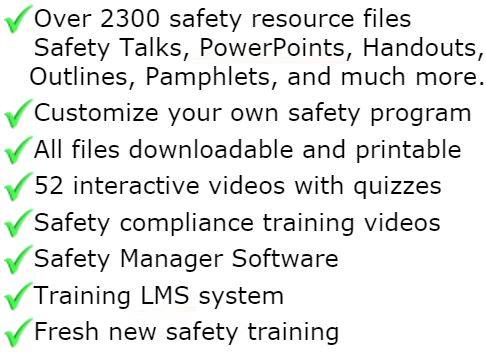
Safety Data Sheets (SDS) Management (Formally MSDS)
Managing Your SDS Program
OSHA requires employers to maintain current Safety Data Sheets (SDS) on all chemicals used in the workplace, train employees on their use and make SDS readily available in the work area.
Centralized management of this effort is the key to efficiency, effectiveness and compliance. This starts with how containers of chemicals are received and distributed throughout your facility.
Getting Started
If you don’t have an SDS system, follow these steps
Determine the chemicals you use. There are several ways to determine what chemicals you have at your location. Using all of the following methods will provided the best coverage to prevent missing something.
1. Make a list of all suppliers that provide material covered by the OSHA standard... Don’t forget that items such as welding rods and bulk processing materials must be included.
2. Get a list from all suppliers of any chemicals they have sent you in the last three years
3. Conduct a thorough workplace survey. Have supervisors inventory all areas. Provide them with a form to record all chemicals found, the storage location, amount and end use.
4. Index all existing SDS by department
5. Send a letter to all suppliers requesting current SDS for all products they provide your company. Keep a checklist to ensure they are received.
6. Compare your SDS index with the list of chemicals from step 2. and 3.
7. Resolve any discrepancies and provide departments with updated SDS copies. Each SDS book location should have a table of contents that lists each chemical SDS that is required to be in that book. Keep a master index of each book and a master SDS in a central file that is controlled by one manager.
Safety Data Sheet Program responsibilities:
Shipping & Receiving Department
Assign your shipping manager as the key point for SDS management. This includes:
· Ensuring current SDS are in the Master book or computer files
· Updating all user department files
· Requesting new SDS from vendors and suppliers every year for all active products
· Manage and maintaining the chemical labeling system
· Notifying the Safety Department when new or modified SDS are added.
· Not releasing new products without permission from Safety Department
· Ensuring all containers are properly labeled before distribution.
Safety Department SDS responsibilities should include:
· Determine chemical safety training requirements for all existing and new products
· Monitor chemical labeling program
· Monitor storage locations
· Verify safe usage procedures
· Making PPE determinations
· Periodically audit department SDS files to ensure they are up-to-date
End User Department responsibilities:
· Ensure proper storage, labeling, dispensing and use
· Train employees on hazards and procedures
· Ensure SDS are readily available
· Ensure labels are legible
· Provide proper transfer and dispensing containers
· Segregate incompatible chemicals
· Control issue and return of unused chemicals
· Conduct weekly chemical safety checks
Off premises use of chemicals
Once you have an complete paper SDS program established, you can now move to an electronic storage system with a high degree of confidence that all material will be covered. The system should provide a means to easily find and sort SDS by Product Name, Department and usage. OSHA requires that a backup method be available in the event of power outages or electronic equipment failure. Currently there are no chemical SDS databases that have all chemicals from all suppliers. You cannot rely on ‘generic" SDS since OSHA requires you to maintain the SDS provided for the specific product from the specific supplier.
Many current commercially developed databases allow for scanning paper copies into the database. This saves time in that data need not be re-typed into a standard format and you maintain the exact SDS provided by the supplier. The scanned files are then made available through the database program’s index system.
Scanned copies will not provide a searchable database unless you can also enter basic information about each file as it is added. As a minimum you will want a program the allows you to enter the name of departments that uses the specific SDS, product name, supplier and current SDS date.

GET INSTANT ACCESS
to THE MEMBERS LIBRARY
Safety materials created by safety professionals.
Access to the Safety Manager software.
Wide variety of safety videos and courses.
**Brand New** Safety Training Management System
Pre-Made Safety Materials Ready For Use
Created by experienced safety professionals & risk consultants. Saving you time, money, and risk of injuries.
95% of the work already done.
Below are the maximum penalty amounts, with the annual adjustment for inflation, that may be assessed after Jan. 15, 2024. (See OSHA Memo, Jan. 8, 2024).

**New OSHA HEAT 90 DAY**
>>Download Free HERE<<
**New 2024 OSHA 300 Form**
>>Download Free HERE<<
**Brand New**
Free with full membership subscription
Training LMS System
Ask The Safety Consultant
Safety Equipment Deal Finder

“SafetyInfo.com is the first go-to website for safety professionals and companies to use in establishing a solid safety program"
-Mike McKenzie, Certified Safety & Health Manager (CSHM), McSafety Solutions™
Note: You must have a full subscription to the Safety Library in order to use this material. Any use outside of your organization, for resell, or without an active membership is strictly prohibited and may result in prosecution under copyright infringement laws. Please contact us first, if you would be interested in reselling or using our materials for reproduction.
Inside the Members Library
Topic Index
Accident Prevention
Air Quality
Asbestos
Bloodborne Pathogens
Boilers
Chemical Safety
Compressed Gas
Confined Space
Construction
Construction Worksite
Cranes & Slings
Driver / Fleet Safety
Drug Free Workplace
Electrical
Emergency Management
Engineering Safety
Environmental
Equipment
Ergonomics
Fall Protection
Fire Safety & Prevention
First Aid
Flammable Materials
Forklifts
Hazard Communication
Hazardous Materials
Hearing Protection
Heat Stress
Hot Work
Housekeeping
Job Safety Analysis
Laboratory
Ladders
Lead
Lockout-Tagout
Machinery & Equipment
Material Handling
MSDS (SDS)
Medical & First Aid
Occupational Health
Office Safety
Off the Job Safety
Personal Protection
Process Safety
Record Keeping
Respiratory Protection
Silica Safety
Rules & Policies
Signs & Labels
Slips, Trips & Fall
Training
Terrorism Programs
Tool Safety
Vehicle & Driver
Violence Programs
Welding & Hot Work
Training Videos
Library Index
Training Materials
Videos/Courses
Talks
Articles
PowerPoint
Handouts
Training Overheads
Quizzes
Supervisor Briefs
Management Briefs
Safety Sessions
2 Minute OSHA Safety Talks
Pamphlets
First Aid Training
Supervisor Training
Hazardous Materials
Bomb Threat
Crossword Puzzles
Biological Agents
Forms & Documents
Forms
Checklists
Audit Guides
Inspections Guides
Signs & Labels
Environmental Audit Guides
Recordkeeping - OSHA 300
Sign & Label Maker
Safety Management Resources
Safety Manuals/Written Programs
Ergonomic Programs
Emergency Plans
Process Safety Management
Construction Safety
Occupational Health
Environmental
Topic Sheets
DOT Fleet-Driver
Hazardous Materials
Chemical Safety
Drug Free Workplace
Terrorism Programs
Development Guides
Safety Manager Software
Safety References & Graphics
Technical Safety Information
Posters
Topic & Fact Sheets
Development Information
Job Specific Safety Rules
Terrorism
Calculators
Safety Comic Strips
New Safety Training System
Schedule and train your employees with our materials. Add unlimited amount of employees. Record all progress and issue certificates. For group and individual training sessions.

